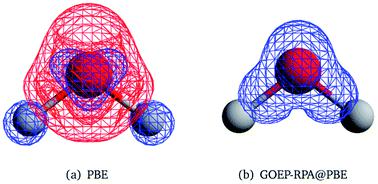当前位置:
X-MOL 学术
›
Faraday Discuss.
›
论文详情
Our official English website, www.x-mol.net, welcomes your
feedback! (Note: you will need to create a separate account there.)
Introductory lecture: when the density of the noninteracting reference system is not the density of the physical system in density functional theory
Faraday Discussions ( IF 3.3 ) Pub Date : 2020-09-02 , DOI: 10.1039/d0fd00102c Ye Jin 1 , Neil Qiang Su 1 , Zehua Chen 1 , Weitao Yang 2
Faraday Discussions ( IF 3.3 ) Pub Date : 2020-09-02 , DOI: 10.1039/d0fd00102c Ye Jin 1 , Neil Qiang Su 1 , Zehua Chen 1 , Weitao Yang 2
Affiliation

|
A major challenge in density functional theory (DFT) is the development of density functional approximations (DFAs) to overcome errors in existing DFAs, leading to more complex functionals. For such functionals, we consider roles of the noninteracting reference systems. The electron density of the Kohn–Sham (KS) reference with a local potential has been traditionally defined as being equal to the electron density of the physical system. This key idea has been applied in two ways: the inverse calculation of such a local KS potential for the reference from a given density and the direct calculation of density and energy based on given DFAs. By construction, the inverse calculation can yield a KS reference with the density equal to the input density of the physical system. In application of DFT, however, it is the direct calculation of density and energy from a DFA that plays a central role. For direct calculations, we find that the self-consistent density of the KS reference defined by the optimized effective potential (OEP), is not the density of the physical system, when the DFA is dependent on the external potential. This inequality holds also for the density of generalized KS (GKS) or generalized OEP reference, which allows a nonlocal potential, when the DFA is dependent on the external potential. Instead, the density of the physical system, consistent with a given DFA, is given by the linear response of the total energy with respect to the variation of the external potential. This is a paradigm shift in DFT on the use of noninteracting references: the noninteracting KS or GKS references represent the explicit computational variables for energy minimization, but not the density of the physical system for external potential-dependent DFAs. We develop the expressions for the electron density so defined through the linear response for general DFAs, demonstrate the results for orbital functionals and for many-body perturbation theory within the second-order and the random-phase approximation, and explore the connections to developments in DFT.
中文翻译:

入门讲座:密度泛函理论中当非相互作用参考系统的密度不是物理系统的密度时
密度泛函理论 (DFT) 的一个主要挑战是开发密度泛函近似 (DFA) 以克服现有 DFA 中的错误,从而产生更复杂的泛函。对于此类泛函,我们考虑非交互参考系统的角色。具有局部电势的 Kohn-Sham (KS) 参考的电子密度传统上被定义为等于物理系统的电子密度。这一关键思想以两种方式得到应用:根据给定密度对局部 KS 势进行逆计算,并根据给定的 DFA 直接计算密度和能量。通过构造,反演计算可以得到密度等于物理系统输入密度的KS参考。然而,在 DFT 的应用中,发挥核心作用的是 DFA 直接计算密度和能量。对于直接计算,我们发现当 DFA 依赖于外部势时,由优化有效势 (OEP) 定义的 KS 参考的自洽密度不是物理系统的密度。这种不等式也适用于广义 KS (GKS) 或广义 OEP 参考的密度,当 DFA 依赖于外部势时,它允许非局部势。相反,与给定 DFA 一致的物理系统的密度由总能量相对于外部电势变化的线性响应给出。这是 DFT 中使用非相互作用参考的范式转变:非相互作用 KS 或 GKS 参考代表能量最小化的显式计算变量,但不是外部电势相关 DFA 的物理系统的密度。我们开发了通过一般 DFA 的线性响应定义的电子密度表达式,展示了二阶和随机相位近似内轨道泛函和多体微扰理论的结果,并探索了与以下领域发展的联系:密度泛函理论。
更新日期:2020-11-03
中文翻译:

入门讲座:密度泛函理论中当非相互作用参考系统的密度不是物理系统的密度时
密度泛函理论 (DFT) 的一个主要挑战是开发密度泛函近似 (DFA) 以克服现有 DFA 中的错误,从而产生更复杂的泛函。对于此类泛函,我们考虑非交互参考系统的角色。具有局部电势的 Kohn-Sham (KS) 参考的电子密度传统上被定义为等于物理系统的电子密度。这一关键思想以两种方式得到应用:根据给定密度对局部 KS 势进行逆计算,并根据给定的 DFA 直接计算密度和能量。通过构造,反演计算可以得到密度等于物理系统输入密度的KS参考。然而,在 DFT 的应用中,发挥核心作用的是 DFA 直接计算密度和能量。对于直接计算,我们发现当 DFA 依赖于外部势时,由优化有效势 (OEP) 定义的 KS 参考的自洽密度不是物理系统的密度。这种不等式也适用于广义 KS (GKS) 或广义 OEP 参考的密度,当 DFA 依赖于外部势时,它允许非局部势。相反,与给定 DFA 一致的物理系统的密度由总能量相对于外部电势变化的线性响应给出。这是 DFT 中使用非相互作用参考的范式转变:非相互作用 KS 或 GKS 参考代表能量最小化的显式计算变量,但不是外部电势相关 DFA 的物理系统的密度。我们开发了通过一般 DFA 的线性响应定义的电子密度表达式,展示了二阶和随机相位近似内轨道泛函和多体微扰理论的结果,并探索了与以下领域发展的联系:密度泛函理论。











































 京公网安备 11010802027423号
京公网安备 11010802027423号